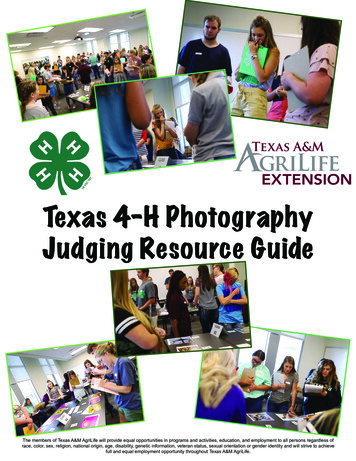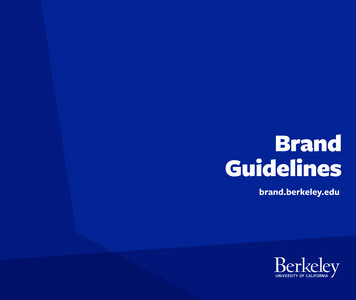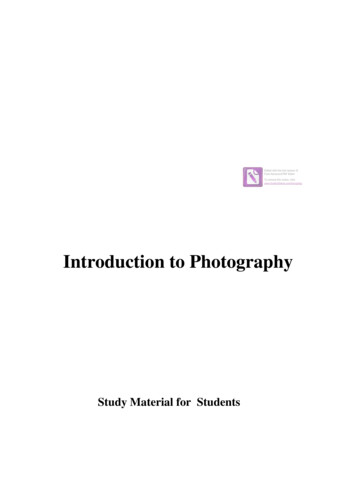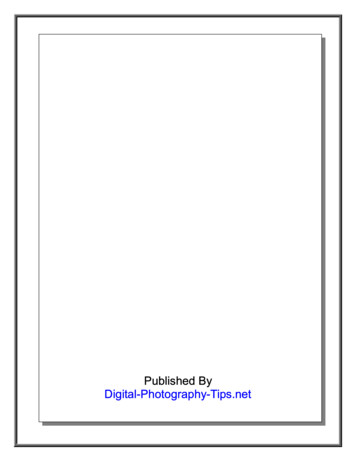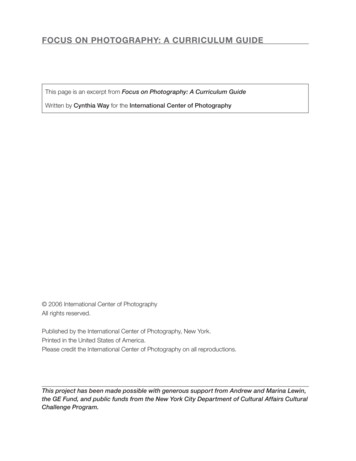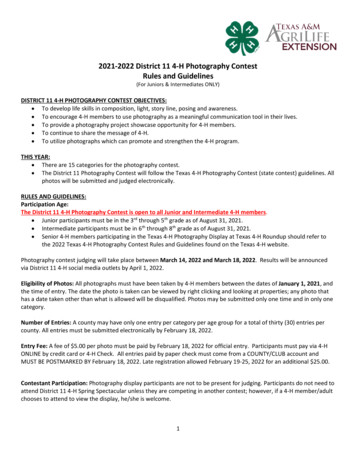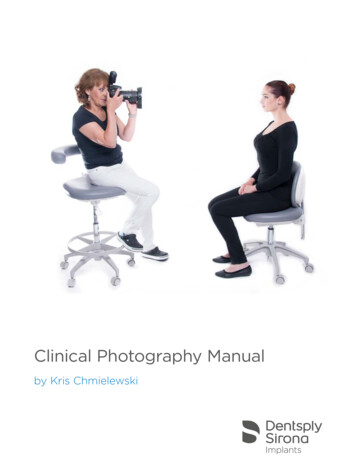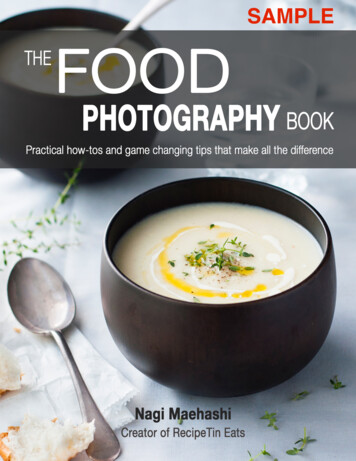
Transcription
SAMPLE1
This is the book I wish I had when I startedlearning food photography.Highly practical. Actual “how to” steps, not justconcepts. I’m sharing all my game changers!Hi there! I’m Nagi from RecipeTin Eats food blog.I was born a foodie. It’s in my blood and it was inevitable thatone day, I would walk away from my corporate finance career topursue a future in the food industry.And that’s exactly what I did. I started my blog and picked up aDSLR camera for the first time in May 2014.10 months later, I was making an independent living from my blog and related activities, includingphoto shoots for commercial clients.There is absolutely no doubt in my mind that the rate at which I was able to grow my blog wasimpacted by my photography. I invested an enormous amount of time researching, learning and mostimportantly, practicing.When I started out, I found that the resources I used were full of tips and concepts, but they didn’tactually explain how to apply all those in practice. And some really big game changing tips werecompletely omitted!As I practiced more and more, things began to “click”. Little things I figured out that made all thedifference.So this is The Food Photography Book. The book where I cover the basics as well as sharing thereally juicy tips that took my photography to a level where I was taking on photography clients lessthan a year after I picked up a DSLR for the first time ever.This is a highly practical book and doesn’t require fancy photography equipment. I use consumergrade equipment (i.e. budget!) and I don’t have fancy extras!I hope you find it useful!- Nagi2
My Number 1 Tip:Don’t try to learn and practice everything at once. Take out as many variables aspossible by starting with a simple “plonk and snap” set up so you canconcentrate on learning lighting, camera angles, where to focus and camerasettings.Use minimal props and just concentrate on the food. Then build on that byadding one extra thing at a time.3
CONTENT STop 10 Game Changers8Then .and now .9Chapter 1: PHOTOGRAPHY EQUIPMENT12Choosing a Camera12Lenses13Other Equipment18Editing and Organising21Chapter 2: CAMERA SETTINGS22Exactly What I Do22Overview23Aperture (f-stop)24ISO26Shutter Speed27Exposure Meter28Shoot RAW. Not JPEG.30White Balance31Camera Settings Cheat Sheet32Chapter 3: LIGHTING33Introduction34The 10 Commandments of Light35Chapter 4: My Secret Lighting Test45Testing for Directional Lighting46Testing for Diffused light47Soft vs Dramatic Lighting48Light Direction49Artificial Lighting51Chapter 5: MANAGING LIGHT52Diffusing Light53Reflectors (Backfills)56Creating Light58How to Create Directional Lighting60Chapter 6: WHICH LIGHTING DIRECTION IS BEST?654
Chapter 7: LIGHTING SET UPS68Backlighting68Style: Blown Out White Background74Side Lighting76Side Backlighting77Chapter 8: ARTIFICAL LIGHTING78Pros and Cons of Artificial Lighting79What Light Should I Use?80Camera Settings82“Must Knows”83Shooting with Two Lowel Ego Lights86Shooting with One Lowel92Backlighting Surface Glare99Style: Easy Dark StyleChapter 9: CAMERA ANGLES100101Camera Angles for Different Foods102Overhead Shots105TIP: Camera Angle & Surface Shine108Chapter 10: WHERE TO FOCUS109Chapter 11: FOOD STYLING111My Tips and Tricks111The Brown Food Challenge118Chapter 12: CROCKERY & CUTLERY120Chapter 13: ACTION SHOTS!124Pour Shot126Scooping/Dipping/Picking up Food127Stretchy Cheese Shots128Sprinkling/Grating/Dusting130Chapter 14: BACKBOARDS/SHOOTING SURFACES131Tips for Choosing Backboards131Sourcing Backboards132My Favourite Backboards1335
Alternative Shooting SurfacesChapter 15: PROPS135136Prop Ideas136Key Tips for Choosing and Using Props138Chapter 16: COMPOSITION139Top Tips139#1 Default Set Up (1-2-3 Set Up)142#2 Default Set Up (Double Up)143Fallback: When in Doubt, Get Up Close and Personal144How Close is Too Close?145How To Shoot Close146Chapter 17: EDITING147What’s Covered148My Workflow148Editing in iPhoto149Photoshop - Introduction15315 Steps - Proper Editing with Photoshop154Step by Step - Editing with Photoshop155Saving Photo Editing Presets in Camera Raw178Shortcut Editing with Photoshop179Chapter 18: TROUBLESHOOTING1836
Then .and Now .Then .and now .Month 1 - May 2014Month 4 - August 2014Month 8 - December 2014Month 15 - July 20159
Then .and Now .What’s WrongShooting under house lights andusing the camera flashYellow shooting surfacesNo stylingWhat’s Right Lighting Styled food Show off its best features!What’s WrongNot enough lightUnflattering yellow tone woodenboard and shooting surfaceCrooked photoWhat’s Right Shot straight! Directional lighting Better styling using dark woodWhat’s WrongWrong props - blue fabricdominates far too much!Too much light washed outphotoWhat’s Right Better, more subtle use of props Directional lighting coming frombehind the food glossy sauce texture and colour enhancement10
LightingChapter 3: LIGHT INGWith great light, you can keep styling and props simple.33
LightingIntroductionLighting is the single most important aspect of photography. With great lighting, you can take abeautiful shot no matter what camera you have, even an iPhone, with simple styling and props.Lighting is also the hardest thing to master. It’s certainly what I struggled with the most. I found that theresources I used at the beginning were focussed on concepts and the practical side was looselyexplained. With practice, I figured lighting out for myself and with each new “thing” that clicked, myphotos drastically improved.So instead of concepts, this book is highly practical and focussed on how to recognise, find and creategreat light to show off the amazing food you create.This book focuses on easy ways to find, recognise, manage and CREATEgreat light for food photos.34
LightingThe 10 Commandments of Light1. Never use the camera flash or take photos under house lights.2. You need enough light .3. .but TOO much light results in washed out photos. Shooting on your covered, open porch andunder the shade of a tree are classic examples. (KEY TIP!)4. Directional lighting is when light is mostly coming from one direction. It makes food look amazing.(KEY TIP!)5. The most flattering light direction for food is side and backlighting. (KEY TIP!)6. Light coming from the front of the food (3 o’clock to 9 o’clock) is the least flattering.7. The smaller the gap through which the light source is directed onto the food, the more dramatic thelighting. That’s how to create dark, dramatic style photos.8. Diffuse your light to make your photos “glow”. Cloudy days are great because light is naturallydiffused. (KEY TIP!)9. Create extra light and reduce unwanted dark areas by using reflectors/bounce cards. (KEY TIP!)10. Taking good photos in direct sunlight is hard. You need strong diffusion and low sun.Use my Secret Lighting Test (page 45).Without taking a shot, you’ll know if the lighting will be flattering.35
LightingRule #1: Never Use House Lights or the FlashDon’t do it! The built in camera flash is not a friend offood. The photo just looks like .well, like it’s beentaken with a flash!Same goes for kitchen lights and any other lights in thehouse. Even if the house lights are bright enough, thebig problem is the hue it casts over the photo.It is virtually impossible to get correct colour tones on aphoto taken under house lights because house lightstend to have warm/yellow tones so it casts a yellowtone over the photos. Fixing the colour balance ofphotos taken under house lights is challenging even forexperienced photographers.House lights don’t do it!Rule #2: You need enough light .If you don’t have enough light, you will either have tocompensate by reducing your shutter speed so low thatyou end up with a blurry photo, especially without atripod, or you’ll end up with a dark, dreary, grey photo.When you learn how to use your manual camerasettings, you will be very surprised at how great photoscome out even in what you think are low light situations.Even in winter, I can shoot until the sun is almostcompletely down and you’d never know by looking atthe photo.Learn how to: Make sure your photos are exposed enough by usingthe Exposure Meter in your DSLR camera - see page28; Use your camera settings to compensate for low lightusing the Camera Settings Cheat Sheet - see page 32;I hit the jackpot with this one - not enough light PLUSflash. Delicious looking! Create extra light using reflectors - see page 56; and Use artificial lighting - see Chapter 8.36
Lighting Set UpsChapter 7: LIGHT ING SET UPSThis chapter walks through how to do the following: Direct Backlighting set up - when the light is comingfrom directly behind the food. This is the light direction Iuse the least; Side Lighting set up - when the light is coming fromdirectly beside the food; and Side Backlighting - my favorite light directionbecause it encompasses the best of backlighting andside lighting and is the easiest to work with.BacklightingBacklighting is a very flattering light direction for foodbecause it makes things “glow”. But it is the most difficult,because: You need to arrange the reflector in a way that it isn'tobstructing the shot; You need to manage overexposure/ “blow out” at theback of the photo; You need to manage the balance between the strengthof light at the back of the photo and the dark front of thephoto. Too much contrast means the back of the photowill be massively blown out with severe loss of detailblurring into the main subject. And not enough contrastwill result either in a totally blown out photo or a photothat looks washed out (i.e. shooting with too muchlight); and You can easily end up with too much reflection on thesurface of food. I went way overboard with backlightingwhen I first discovered it!68
Food StylingChapter 11: FOOD STYLINGFood styling refers to how you style the food to make it look as amazing as it tastes. Some foods, likebrightly coloured dishes, are far easier to style than foods that “look ugly” but taste amazing. A classicexample is “brown foods” - like casseroles and curries.Food styling is such an art that people make a career out of it! Photo shoots for gourmet magazinesand cookbooks typically involve a recipe developer, a cook, food stylist and photographer.Professionals often cook different components of a dish separately then assemble it for the shot as itgives them great control over the styling. So for example, to take a shot of a one pot pasta - cook thepasta, sauce, vegetables etc separately, then put it together for the photo.I do not do this! This book is a little more practical for real life and assumes that the food is cooked asper the recipe.My Tips and Tricks1. Show off the greatest feature of the dishBefore you plate up the food, the thing you must ask yourself isthis: “What is the greatest feature of this recipe?”Once you get in the habit of this, styling your shot is going tocome much more easily because you will automatically startplating up your food in a way that shows it off the most. Andseeking a lighting angle that shows off that feature the best.In the photo on the right, the feature is the sticky sauce on thechicken. I made sure to use side backlighting and shoot fairly lowso the surface of the chicken would look nice and glossy.2. Garnish, garnishAlmost everything looks better with a little bit of garnish, even ifyou wouldn’t use it in real life! Whether it’s a sprinkle of crushednuts, scallions/shallots, herbs or spice, or even more of one of theingredients in the dish, almost every food benefits from a touch ofsomething.Tip: Keep a bag of dried parsley handy! It’s a lifesaver for those days when you don’t have freshherbs. It comes out pretty green in photos and you’d have to inspect it closely to know it’s dried!The other thing I have taken to doing is freezing chopped parsley. Curly parsley, rather than flat leafparsley, works the best because it stays separated and “fluffy” when it freezes, making it easy to takea pinch and sprinkle it lightly over the food. Sprinkle while frozen as once it defrosts, it becomes wetand you can’t sprinkle it as easily. Also, chopped parsley keeps for around 1 week in the fridge andstays green enough. Most of my photos use either DIY dried or frozen parsley garnish!111
Backboards/Shooting SurfacesChapter 14: BACKBOARDS/SHOOT ING SURFACESTIP: The more interesting, weathered and textured a shooting surface is, the less props you need.Having one great backboard makes a profound impact on your food photography. A really great rustic,textured, weathered backboard not only adds loads of character and mood to a photo, but it alsomeans you can use far less props in a shot because the shooting surface itself is so much moreinteresting. The more interesting the backboard is, the less styling and props you need.I fluffed around for ages in the early days trying to find backboards and figuring out which ones workedbest. You don’t need to spend a fortune on backboards - though it is easier if you buy them fromspeciality photography prop stores! I personally have never spent more than 10 on a backboard.If there’s one piece of advice I can give you about props, it’s this: Invest the time to find or make onegreat backboard. Even if it means skipping a post because of time limitations. It is worth its weight ingold. I wish someone had emphasised that to me when I started out!Tips for Choosing Backboards1. Cooler colours are easier to use. Avoid yellowy and orange tones. They just aren’t flatteringand are harder to work with (until you become a pro!). Whites, grey tones and dark colours areeasier to work with. Styling can be kept simple when usingshooting surfaces with texture.X Avoid yellow and orange tone surfaces.X Avoid shiny laminate surfaces.131
EditingAs I mentioned on page 162, I have a slight preference towards the Tone Curves but that is because Ihave become comfortable with using them.So to get the contrast balance in the Nachos Pie photo to my taste,I would use the Tone Curves more than the Tone Sliders.Here are the settings I have decided I am happy with: Tone Sliders - all pulled back to around half the settings in step 8;and Tone Curve - left the same as per step 9.Here’s the edited photo I’m moving forward with.164
EditingThat’s it! And here’s the post edited shot. Not bad for a few quick clicks!Out of cameraAfter editing.Remember: This shortcut editing approach only works for decent photos. I hardly ever edit photosthis way. If it’s a “problem” photo, edit it properly using Camera Raw - refer to page 155 for a step bystep.182
So this is The Food Photography Book. The book where I cover the basics as well as sharing the really juicy tips that took my photography to a level where I was taking on photography clients less than a year after I picked up a DSLR for the first time ever. This is a highly practi

